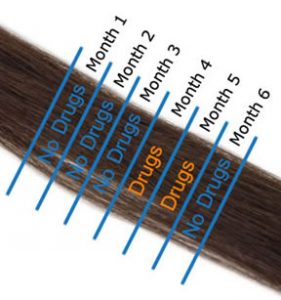A positive result for a screening test indicates the presence of the targeted substance in the test sample. The interpretation of this result involves a delicate process. This is aimed at ensuring accuracy and reliability.
interpretation of this result involves a delicate process. This is aimed at ensuring accuracy and reliability.
In blood or saliva, a positive result generally indicates recent consumption. In the urine, a positive result can indicate both recent and historical consumption. Drug testing in the hair helps to track long-term consumption. It is thus possible to know if drug use is continuous or occasional. On the other hand, recent consumption cannot be detected.
Screening for drugs using the hair is not the preferred route because it is difficult to detect. It is reserved for only a few specific situations, such as doping or forensics. No drug tests can tell if a person is addicted. Similarly, tests available to the general public do not qualify the type of consumption, whether occasional or regular.
Can the tests be wrong?
At present, screening tests involve techniques that are sufficiently proven to have a high-reliability rate. However, it can happen that a person has taken drugs but the result of the screening test is negative. This is called a false negative.
On the contrary, it may happen that a person who has not used a drug is tested positive. This is called a false positive. The main cause of false positives is the detection of active ingredients also present in the composition of certain drugs. A person who has not taken a drug, but who tests positive should report any recent drug intake and ask for a second opinion using a quantitative screening test.
Long exposure to cannabis smoke in a small, unventilated room may be the cause of a false positive.
Access to the results of a drug test
Apart from the doctor who prescribed the analysis, the requesting organization (employer) and the laboratory that performed it, only the person tested has the right to know the results. There are exceptions, however. In the context of legal proceedings, the prosecutor, the judge, the judicial police officers have the right to access the information. As part of a doping control, the federation or club to which the athlete is affiliated is notified. In the case of screening on a minor, the parents are informed.
Employers, heads of schools, spouses, and parents of adult children, regardless of whether they are sponsored or not cannot be the recipients of a drug test result…
Cannabis users may be screened for a variety of reasons. Generally, these tests are performed on body fluids or hair.
In urine, the duration of detection is even more variable when compared to blood tests. Extreme cases have been reported more than six weeks after last use, although there may be negative detection a week later. Urine removes unchanged THC but especially metabolism products, mainly THC-COOH. Detection after single use varies between one and seven days, two to three weeks for more regular consumption, and other factors. Reduced THC passes blood in saliva, so the metabolites are thinly concentrated
Click here to find out more information on hair follicle drug testing.